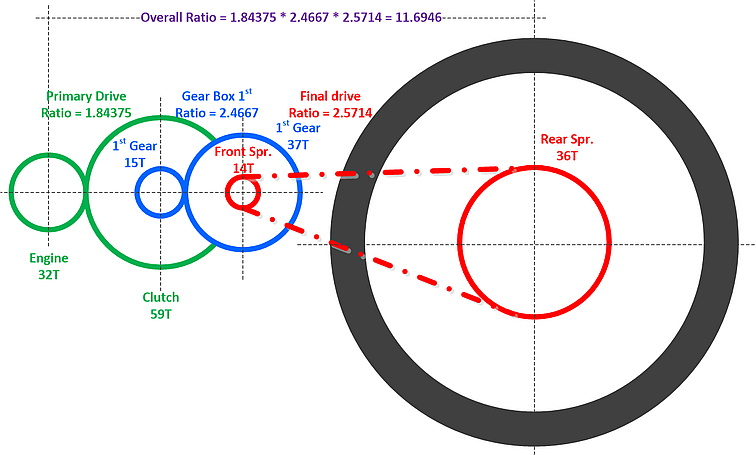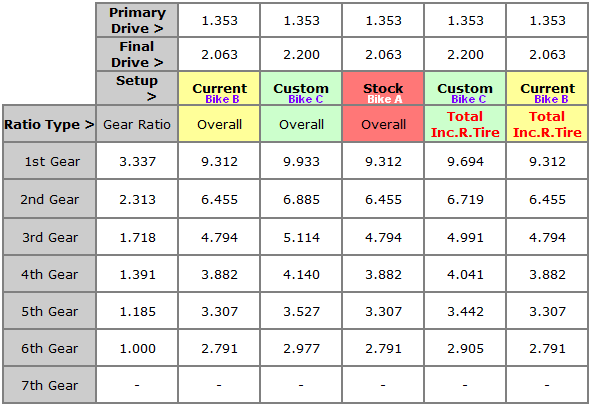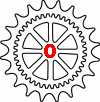Gearing Explained
Drive Train and Power Train
The drivetrain
of a motor vehicle is the group of components that deliver power to the driving
wheels. This excludes the engine or motor that generates the power. In contrast,
the powertrain is considered as including both the engine or motor, and the
drivetrain.
For a motorcycle the rear
wheel is also part of the power train as it delivers the power to the
road.
So the size of the rear tire also affects the entire drive train
ratio.
Gear Ratio
According to
Wikipedia Gear Ratio is:
"The relationship between the number of teeth on two gears that are meshed or
two sprockets connected with a common roller chain, or the circumferences of two
pulleys connected with a drive belt."
But in a
motorcycle the are more than one gear at work so there also are more gear ratio.
All these are working together and form the overall ratio. Most gearing consists
off:
-
Primary
drive, this is the gear ratio between engine RPM and the clutch shaft RPM,
also called 'Primary reduction ratio'
-
Gearbox
ratio, this is the ratio between the clutch shaft RPM and the countershaft
RPM. Because there are more gears in a gearbox, different ratio are possible
-
Final drive
ratio, this is the ratio between countershaft RPM and rear sprocket RPM
-
The ratio
between the Rear sprocket and the rear wheel (rear tire that is !)
All of these
influence the speed of your bike at a certain RPM.
Overall Gearing Ratio
The
overall gearing of a motorcycle consists of 3 major parts:
- The primary
drive, the ratio between the engine (crankshaft) and the clutch or gearbox.
- The gear box
it self, depending on the amount of gears this part has an equal amount of ratio
to choose from
- The Final
drive, (or secondary) ratio between the number of teeth on the Rear sprocket and the
Front sprocket
All
these ratio combined results in the Overall Gearing
Ratio of the power train:

Changing
any of these parts or changing the rear wheel tire's
dimensions will affect speed and / or torque results. All of
these changes can be simulated by using the GC by changing involved
gearing fields. To be able to do this correct, all ratio, sizes and RPM's are
mandatory input.
Primary Drive
The
primary drive is the ratio between the engine's crankshaft and the incoming shaft
of the gear box or clutch. Usually this ratio can not be easily altered unless you
perform major surgery on your bike.... But if you do, don't forget to change the
Primary Drive Ratio field in the GC accordingly.
The gear box
The gear
box is the only gearing part that can change its ratio very easily and
that is by you changing gear while you drive. Normally a gear box is
dedicated for an engine or bike so you do not have to modify gear ratio
in the gearbox itself. But sometimes the stock gears are not suited for
all circumstances and manufacturers offer a way to change the internal
gear box ratio by either offering different cogwheels or by offering a
so called cassette gearbox that can be swapped easily. That is why in
the GC you can change the gear ratio of each gear by changing the values
in the red and blue gear box ratio fields for each gear.
The Final Drive
and consequences of changing it
The
final drive ratio is the last bit of gearing between your transmission
and the driven wheel. In
our example the Final Drive ratio is the ratio of the final part of the
gearing, the ratio between Rear and Front sprocket. This is also
referred to as 'Secondary Ratio'.
Below a
table containing the possible final drive gearing (ratio) changes and their results
on Speed and Torque.
As a
rule of thumb, changing the front sprocket with 1 tooth, amounts to
the same effect as changing the rear sprocket with 3 teeth. This does
not exactly apply to every bike but as a rule of thumb it will do and
explains the results in the table below.
|
Change |
Result On |
|
Front1 Sprocket |
Rear1
Sprocket |
Final Drive Ratio |
Speed2 |
Torque2 |
Chain length needed |
Needed Rear
3
wheel Adjustment |
|
+1 |
-
1 |
down |
++++ |
---- |
shorter |
<-> |
|
+1 |
same |
down |
+++ |
--- |
longer |
>- -< |
|
+1 |
+1 |
down |
++ |
-- |
longer |
>- - - - - - - - < |
|
same |
-
1 |
down |
+ |
- |
shorter |
<- - -> |
|
same |
+1 |
up |
- |
+ |
longer |
>- - - < |
|
-
1 |
-
1 |
up |
-- |
++ |
shorter |
<- - - - - - - -> |
|
-
1 |
same |
up |
--- |
+++ |
shorter |
<- -> |
|
-
1 |
+1 |
up |
---- |
++++ |
longer |
>-< |
| LEGEND |
Meaning |
|
1:
Sprockets |
'+1' means adding 1 tooth and
'-1'
means removing 1 tooth |
2:
Results On
Speed & Torque |
'+' means the speed (or torque) will go up,
'-'
means the speed (or torque) will go down
Where '++++' means a 4 time
as big affect of course. |
3:
Rear Wheel
Adjustment |
< - > means move rear wheel backwards,
> - < means move rear wheel forwards
Where <- - - - - - - -> means move it more than <- ->
of course.
Rear wheel adjustments assuming you keep the current chain ! |
As you
can see, the effect of adding a front tooth and keeping the rear the
same has about 3 times more influence on the speed than removing 1
tooth in the rear and keeping front the same. Changing only the rear
with 1 tooth does not have a lot of effect, you can use it to 'fine
tune' the final drive. In combination with also
changing the the front it either amplifies or weakens the total effect.
When you change more than just 1 tooth in front and/or rear, the results
will increase significantly of course.
The
exact increase or decrease
in both % and actual speed for your bike can be calculated using the Gearing Commander tables.
Combining
all these individual ratios results in the
Overall power train ratio or the Overall ratio.
Just multiply all the
ratio to get the Overall Ratio = Primary ratio * Gear Box ratio
* Final
Drive ratio
Rear wheel Tire Size
changes and their consequences
As the
rear tire is a major part of the total bike gearing, changing its size
does impact this gearing and hence impact speed and torque at certain
RPM's. This is easy to explain: the chain, belt or drive shaft is rotating
the rear wheel at a certain RPM. Now when it is a small wheel in
diameter it will have a small circumference and when rotated it will
cover only a small distance. A bigger wheel will cover a bigger distance
when rotated equally fast.
So
changing for instance your rim size from 16" to 17" would mean a higher
(top-)speed at the same RPM.
But not only changing the rim size influences gearing, also
just changing the
width of a tire changes gearing.
How come ? Well the tire circumference will change as there is a relation
between the height of the tire and it's width:
The
height of the tire is a percentage of the width. Also the height of the tire affects the circumference and hence the speed.
A modern tire has size marks on it like this '190 / 50 / 17' which means: the tire width is 190 mm, the rim
diameter size is 17" and the height of the tire is 50% of the width ( 50% of 190 = 95 mm).
Let's asume you have an older bike
(1982 Suzuki GS750T) which was originally fitted with a 4.5H17
4PR rear tire which is not available anymore and you want to
replace it with a similar modern tire. The original tire has a width of
4.5" which is 114.3 mm. It's circumference was 2074.7 and theroretical
top speed 208.1 Km/h. A similar wide modern tire could either be a
120/90/17 or a 130/80/17.
Though
all 3 mentioned tires have the same rim size, as their width and heights
are different, so will be their circumference:
4.5H17
4PR - width = 114.3 mm, circumference = 2074.7 mm, theoretical top
speed: 208.1 Km/h
120
/ 80 / 17 - width = 120 mm, circumference = 2035.1 mm, theoretical top speed: 204.1 Km/h
130 / 90 / 17 -
width = 130 mm, circumference = 2010.0 mm, theoretical top speed: 201.6
Km/h
'Total' Gearing Ratio
As
shown above, the tire size does affect the speed of the bike but it is not
part of the commonly used 'Overall Gearing Ratio'. Say we want to
compare 2 identical bikes, so having the same primary drive ratio, the
same gearbox ratio and also the same final drive ratio but having rear
tires with different sizes. This will resullt in an Overall Gearing
Ratio which is the same for both bikes but they will perfom differently
due to the different rear tire circumferences. So at a fixed RPM they
will both reach different speeds.
The same 'difference in speed'
could be achived by both bikes having the same rear tire size but giving
them a different overall gearing ratio'. Now in order to see how much
the rear tire affects the speed as opposed to the same bike with the
stock rear tire, a new overall gearing ratio is calculated which
incoporates the rear tire size ratio of both bikes.
Example
Harley Davidson Softail FXSB Breakout '13-'16:
Stock Bike A: Tire =
240/40/18, circumference = 80.30", speed @5600RPM = 152.6 Mph, Overall
ratio = 2.791
Current Bike B: Tire = 260/40/18,
circumference = 82.28", speed @5600RPM = 156.4 Mph,
Overall ratio = 2.791
For the first bike (A) with the stock tire
to get to 156.4Mph @5600 RPM, the overall gearing ratio would have to be
(RPM * Circumference) / (Speed/min) = (5600 * 80.3)
/ ((156.4 /60) * 63360) = 2.723
So the effect of
having a different rear tire on bike 'B' as compared to the
otherwise same bike 'A' is the same as changing the overall gearing
ratio of bike 'A' from 2.791 to 2.723.
Incorporating the
rear tire ratios into the overall ratio creates the 'Total Gearing
Ratio'. This Total Ratio is also shown in the table "Overall and Total
Ratio" which is calculated and shown when clicking the 'Overall & Total Ratio' button on the home page.

Now say Custom bike 'C' is like bike 'B' (so with the wider rear tire) and also has a smaller front sprocket, 30 instead of 32.
This means the Overall Ratio will be different as the final drive changed and the Total Ratio will change because of the changed Overall Ratio and a changed rear tire.
Custom Bike C, Tire = 260/40/18, circumference = 82.28", speed @5600RPM = 146.6 Mph, Overall ratio = 2.977
By changing to a wider rear tire, the Total Ratio changed to 2.905
Top of page More info on Tire Circumference
Back to Gearing Commander Main page
|








